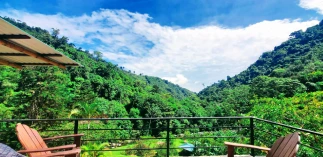High up in the canopy, a flash of gray catches your eye. It could be the Costa Rican squirrel darting through the leaves, but a closer look reveals a sharp beak and piercing yellow eyes – the Gray Hawk, a common resident in the mountain ecosystems surrounding our retreat. This adaptable raptor is a thrilling sight, offering a glimpse into the dynamic world of Costa Rican predators.
A Master of Many Habitats:
While the Gray Hawk thrives in our mountain retreat, its range extends throughout Costa Rica. You might spot it soaring above the forest edges, perched on a roadside wire in the Central Valley, or even patrolling agricultural fields. This adaptability allows it to find prey in a variety of landscapes.
A Portrait in Gray Majesty:
Adult Gray Hawks are a sight to behold. Their bodies are a stunning, pale gray, almost like a cloud sculpted into a feathered form. The underparts are adorned with thin white bars, adding a touch of elegance. The tail, a stark contrast, is banded black and white, flashing a distinctive signal during flight. Don’t forget the piercing yellow eyes, ever watchful for prey.
Juvenile Deception:
While adults are a study in cool grays, juveniles wear a different coat. Brown and heavily streaked, they might be mistaken for other young raptors. But a closer look reveals some unique features – a bolder facial pattern, paler underwings, and a small white patch at the base of the uppertail. These clues help birders distinguish the young Gray Hawk.
The Art of the Hunt:
Soaring effortlessly on strong wings, the Gray Hawk is a patient predator. It scans the landscape from perches or uses a characteristic quick-flap, glide technique to cover ground. Once it spots prey, a swift dive and sharp talons secure a meal. Lizards, snakes, small mammals, and even other birds are all on the menu.
A Song in the Mountains:
The Gray Hawk isn’t just a visual treat. Listen closely and you might hear its clear, whistled song. This call often rings out through the mountains, a reminder of the unseen drama unfolding high above the forest floor.
A Species of Success:
The Gray Hawk’s adaptability allows it to thrive in a changing world. Unlike some raptors that require vast tracts of undisturbed forest, the Gray Hawk can make a living in fragmented landscapes. This makes it a relatively common sight, even in areas with some human activity.
Spotting Your Own Gray Hawk:
If you’re staying at our mountain retreat, keep your eyes peeled for the Gray Hawk. Here are some tips:
- Scan the treetops and forest edges, especially in clearings and along rivers.
- Look for birds perched on wires or tall trees.
- Listen for its clear whistled song.
- With a little patience, you might just be rewarded with a sighting of this magnificent raptor.
The Gray Hawk is a testament to the remarkable diversity of Costa Rican birdlife. Its presence adds another layer of wonder to your experience at our mountain retreat. So, grab your binoculars, head outdoors, and see if you can spot this feathered hunter soaring through the Costa Rican mountains.
For more information, please view our comprehensive guide about the birds of Costa Rica







